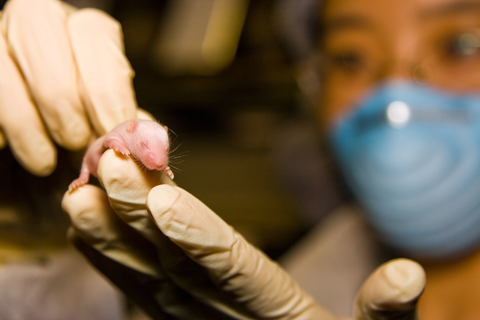Why you shouldn’t pick lab mice up by their tails

A new study shows how mice are picked up can substantially change their behaviour in cognitive tests (University of Liverpool, 2017). The work, by Dr Kelly Gouveia and Professor Jane Hurst from the University of Liverpool was funded by the NC3Rs and is published in Scientific Reports.
The researchers discovered that mice handled by a “mouse-friendly” tunnel for transfer to the test arena showed much more active exploration during testing than those picked up by the tail, which had a major positive impact on test performance.
In the tests, mice were placed near a new attractive stimulus, urine from a mouse of the opposite sex, that should encourage them approach and investigation, especially during the first contact. This was repeated in three sessions, to get the mice familiar with the new scent. Throughout all the sessions, mice picked by the tail showed very little willingness to explore the test arena and therefore investigate the new stimulus. Many animals failed to sniff the stimulus even once, making it challenging to compare the sessions and to collect enough data to reach statistical significance. By contrast, mice picked up in a tunnel explored their environment readily, showed a strong interest in the new stimulus.
To test discrimination between two different scents, the mice were placed near a different urine stimulus. Because the performance of mice picked up by the tail was so poor from the start, they did not discriminate between the known and new scents. Those handled by a tunnel showed robust discrimination, making them much more reliable experimental subjects.
The traditional way to pick up a mouse from its cage is by grasping the base of the tail, although this has no scientific validation. This method, although fast and not painful, is known to be aversive to mice and to cause stress and anxiety.
Jane Hurst said “The method used to pick up laboratory mice has a surprisingly strong influence on their anxiety, and our study shows that this has a major impact on the reliability of their behavioural response to test stimuli. A simple change to picking up mice up in a tunnel rather than by the tail could have a really positive impact on the wide range of research that relies on behavioural testing, as well as improving the well-being of test animals.”
Dr Mark Prescott, NC3Rs, said “This study provides further evidence for the need to shift away from tail handling of laboratory mice, this time for scientific reasons. Tunnel handling should be the method of choice for researchers conducting behavioural tests with these animals.”
In previous work, Jane Hurst and the University of Liverpool team developed alternative methods of handling mice that are much more animal-friendly and just as quick once the handlers are trained. This involves picking up mice by guiding them into an open tunnel that is inexpensive and autoclavable. They showed that this technique makes a big difference to how mice respond to the handler. Mice picked up by the tail show caution and are reluctant to approach the handler, whereas mice used to the tunnel interact with the tunnel and with the person handling them much more willingly.








